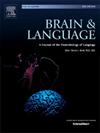Subject relative clause preference in Basque: ERP evidence
IF 2.3
2区 心理学
Q1 AUDIOLOGY & SPEECH-LANGUAGE PATHOLOGY
引用次数: 0
Abstract
Subject-object processing within relative clause (RC) attachments exhibits cross-linguistic asymmetries influenced by various factors, including filler-gap linear or structural distance, morphological case marking, and subject-first preferences (Lau & Tanaka, 2021). In the Basque language, filler-gap linear distance and morphological case marking have been posited as explanatory factors for the observed object relative clause (ORC) preference in prenominal RCs (Carreiras et al., 2010). However, recent studies by Yetano et al., (2019) have identified a behavioral preference for subject relative clause (SRC) constructions in Basque postnominal RCs. To ascertain the primary determinant impacting RC processing, we employed EEG signatures to scrutinize subject-object preferences in temporally ambiguous Basque postnominal RCs. Analysis of event-related potentials (ERPs) unveiled a SRC preference: ORCs elicited augmented negative (LAN: 200–400 ms) and positive (P600: 700–900 ms) components compared to SRCs. Our findings suggest that preferences in RC disambiguation are predominantly shaped by filler-gap linear distance and/or subject-first bias.
巴斯克语中的主语相对从句偏好:ERP证据
相对从句(RC)附着中的主客体加工表现出受各种因素影响的跨语言非对称性,这些因素包括填词间隙线性或结构距离、形态大小写标记和主语先行偏好(Lau & Tanaka, 2021)。在巴斯克语中,填词间隙线性距离和形态大小写标记被认为是在前名相对从句中观察到的宾语相对从句(ORC)偏好的解释因素(Carreiras et al.)然而,Yetano 等人(2019 年)的最新研究发现,巴斯克语名后 RC 中的主语相对从句(SRC)结构具有行为偏好。为了确定影响 RC 处理的主要决定因素,我们采用了脑电图特征来仔细研究时间上模棱两可的巴斯克名后 RC 中的主宾偏好。事件相关电位(ERPs)分析揭示了 SRC 偏好:与 SRC 相比,ORC 引起了增强的负向(LAN:200-400 ms)和正向(P600:700-900 ms)成分。我们的研究结果表明,RC消歧中的偏好主要是由填充间隙线性距离和/或主体优先偏差形成的。
本文章由计算机程序翻译,如有差异,请以英文原文为准。
求助全文
约1分钟内获得全文
求助全文
来源期刊

Brain and Language
医学-神经科学
CiteScore
4.50
自引率
8.00%
发文量
82
审稿时长
20.5 weeks
期刊介绍:
An interdisciplinary journal, Brain and Language publishes articles that elucidate the complex relationships among language, brain, and behavior. The journal covers the large variety of modern techniques in cognitive neuroscience, including functional and structural brain imaging, electrophysiology, cellular and molecular neurobiology, genetics, lesion-based approaches, and computational modeling. All articles must relate to human language and be relevant to the understanding of its neurobiological and neurocognitive bases. Published articles in the journal are expected to have significant theoretical novelty and/or practical implications, and use perspectives and methods from psychology, linguistics, and neuroscience along with brain data and brain measures.
 求助内容:
求助内容: 应助结果提醒方式:
应助结果提醒方式:


